Do you have a question about the La Crosse Technology WS2300 and is the answer not in the manual?
Explains the intended application and purpose of the weather station.
Details the base station's function in measuring indoor environment and receiving outdoor data.
Covers warnings regarding improper handling, alterations, battery usage, and product use.
Guides the initial setup of the base station and sensors using adapter or batteries.
Details the process of inserting batteries into the thermo-hygro sensor and base station.
Explains how to connect and power the base station using the included AC adapter.
Describes how to connect the thermo-hygro sensor to the base station via cable for data transfer.
Explains using wireless 433MHz for data transmission from sensors to the base station.
Provides key considerations before drilling mounting holes and affixing units.
Details placing the base station on a flat surface or wall mounting.
Instructs on mounting the wind sensor onto a mast for proper rotation and connection.
Guides secure mounting of the rain sensor 1 meter above ground, checking for proper drainage.
Recommends an ideal mounting location for the thermo-hygro sensor and wall mounting instructions.
Details time, date, forecasting icons, air pressure, and alarm sections of the LCD.
Covers indoor/outdoor temp/humidity, wind chill, dew point, rainfall, and alarms on the LCD.
Explains wind direction, wind speed, and respective alarm sections on the LCD.
Explains DCF77 reception and how to change date display format using the PLUS(+) key.
Explains weather icons (Sunny, Cloudy, Rainy) and tendency indicators for air pressure.
Covers air pressure reading, toggle between relative/absolute, and hPa sensitivity settings.
Details indoor/outdoor temp/humidity, wind chill, dew point, and notes on their phenomena.
Explains wind direction display on the LCD compass and speed display.
Details the functions of all 8 keys for operating the weather station.
Allows changing basic settings like LCD contrast, time, date, and units.
Details how the base station scans for radio-controlled time and manual setting.
Provides information on MIN/MAX values of weather data and recording times.
Explains how to toggle between maximum, minimum, and current records with time and date.
Covers the list of 13 alarm modes and general procedures for setting them.
Details setting high/low alarms for indoor/outdoor temperature and humidity.
Guides setting high/low alarms for wind chill and dew point.
Details setting high/low alarms for rainfall (24h/1h) and pressure.
Guides setting alarms for wind speed (high/low) and wind direction.
Explains storm warning alarm setup and master buzzer ON/OFF control.
Describes the use of additional cables to increase connection distance and potential interference.
Provides steps for replacing batteries in the thermo-hygro sensor.
Details the process for replacing batteries in the base station unit.
Lists common issues like distance, shielding, interference, and no reception with solutions.
Lists detailed specifications for outdoor and indoor data measurements and ranges.
Explains the intended application and purpose of the weather station.
Details the base station's function in measuring indoor environment and receiving outdoor data.
Covers warnings regarding improper handling, alterations, battery usage, and product use.
Guides the initial setup of the base station and sensors using adapter or batteries.
Details the process of inserting batteries into the thermo-hygro sensor and base station.
Explains how to connect and power the base station using the included AC adapter.
Describes how to connect the thermo-hygro sensor to the base station via cable for data transfer.
Explains using wireless 433MHz for data transmission from sensors to the base station.
Provides key considerations before drilling mounting holes and affixing units.
Details placing the base station on a flat surface or wall mounting.
Instructs on mounting the wind sensor onto a mast for proper rotation and connection.
Guides secure mounting of the rain sensor 1 meter above ground, checking for proper drainage.
Recommends an ideal mounting location for the thermo-hygro sensor and wall mounting instructions.
Details time, date, forecasting icons, air pressure, and alarm sections of the LCD.
Covers indoor/outdoor temp/humidity, wind chill, dew point, rainfall, and alarms on the LCD.
Explains wind direction, wind speed, and respective alarm sections on the LCD.
Explains DCF77 reception and how to change date display format using the PLUS(+) key.
Explains weather icons (Sunny, Cloudy, Rainy) and tendency indicators for air pressure.
Covers air pressure reading, toggle between relative/absolute, and hPa sensitivity settings.
Details indoor/outdoor temp/humidity, wind chill, dew point, and notes on their phenomena.
Explains wind direction display on the LCD compass and speed display.
Details the functions of all 8 keys for operating the weather station.
Allows changing basic settings like LCD contrast, time, date, and units.
Details how the base station scans for radio-controlled time and manual setting.
Provides information on MIN/MAX values of weather data and recording times.
Explains how to toggle between maximum, minimum, and current records with time and date.
Covers the list of 13 alarm modes and general procedures for setting them.
Details setting high/low alarms for indoor/outdoor temperature and humidity.
Guides setting high/low alarms for wind chill and dew point.
Details setting high/low alarms for rainfall (24h/1h) and pressure.
Guides setting alarms for wind speed (high/low) and wind direction.
Explains storm warning alarm setup and master buzzer ON/OFF control.
Describes the use of additional cables to increase connection distance and potential interference.
Provides steps for replacing batteries in the thermo-hygro sensor.
Details the process for replacing batteries in the base station unit.
Lists common issues like distance, shielding, interference, and no reception with solutions.
Lists detailed specifications for outdoor and indoor data measurements and ranges.
| Brand | La Crosse Technology |
|---|---|
| Model | WS2300 |
| Category | Weather Station |
| Language | English |

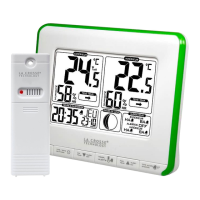
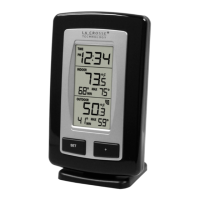



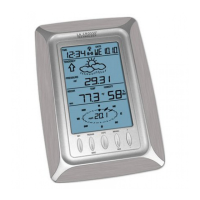
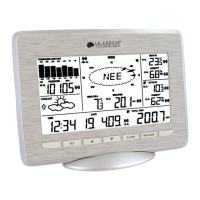


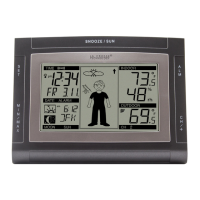
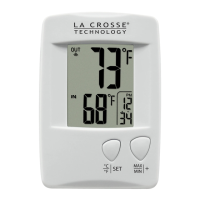
